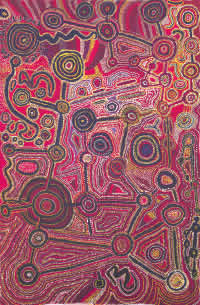The Spinifex people, or Pila Nguru, are Aboriginal people whose
traditional lands are situated in the Great Victoria Desert
in Western Australia, adjoining the border with South Australia,
north of the Nullarbor Plain. Their 'common' name comes from
Spinifex grasses, which are the dominant feature of the landscape
in this desert region.
The Spinifex Arts Project was established in 1997 as part of
a Native Title Claim in which the traditional owners of the
Spinifex Country sought and secured title over their lands.
During preparation of the land claim, artists recorded their
connection to their country in the form of a series of large
and magnificent paintings. From this experience, the artists
have continued to express their close association with the Spinifex
country.
The Spinifex People
The Spinifex People were dispossessed from their homelands
in the Great Victoria Desert in the 1950s, when their country
was selected for the Maralinga atomic testing which was carried
out between 1952 and 1957 by the British and Australian governments.
During that time many of the people were moved to missions
including Cundeelee and Warburton in Western Australia, hundreds
of kilometres from their country. About 200 people were recorded
as still being on the Spinifex homelands in the period 1955
to 1963, and most of these were moved on to mission settlements.
In the early 1980s Cundeelee mission closed. The Spinifex People
were moved again to other lands before eventually settling at
Tjuntjuntjara, a newly selected outstation camp in the south-western
corner of Spinifex homelands.
Since establishing a secure living area within traditional
lands at Tjuntjuntjara, the community has developed into a stable
and important focus for the regional cultural cycles of Western
Desert life. As the community has grown, people from throughout
the region with traditional attachment to the area have returned
to live at Tjuntjuntjara.
Once Tjuntjuntjara was established, the Spinifex Native Title
claim was lodged in 1996 and plans for development of Ilkurlka
Roadhouse were started. Ilkurlka is located in the centre of
the Spinifex Native Title claim and is named after a nearby
rockhole which is a major site in the Kalaya (Emu) story.
|
A Native Title agreement over the region was ratified
by the Federal Court in November 2000. Celebrating the
success of the land claim, the Spinifex People donated
ten major paintings to the people of WA to be housed at
the Western Australian Museum.
Having successfully negotiated the Native Title claim,
the Spinifex people continue to record and document their
traditional stories and traditional knowledge through
the medium of acrylic painting on canvas.
Bush trips to local sites, birthplaces and Ilkurlka Outstation
are still the main forums for producing paintings. Collaborative
works are signature pieces for the Spinifex people and
are keenly sought by collectors and institutions. |
 Men's Native Title Painting 1998
Men's Native Title Painting 1998 |
Up to eight senior men and women may work on separate collaborative
works, painting Jukurrpa or sacred stories such as The Seven
Sisters, Wati Kutjara, Karlaya story and many other stories
from the wider Spinifex area. Individual works are also produced
during such trips and all paintings are documented and photographed
for the communities archive.
Over the last decade artists from the Spinifex Arts Project
have held exhibitions in major cities around Australia and have
also held three exhibitions overseas.
Work by artists of the Spinifex Art Project is available
on our Spinifex
Paintings pages.
Next: Spinifex Country